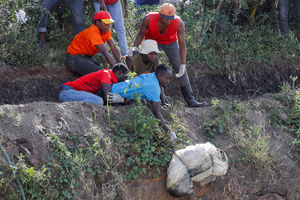
Collins Jumaisi Khalusha before Kiambu Law Court on July 16, 2024. (Inset) Photos of his rental house in Kware.
The small steel gate with faded blue paint leads into the makeshift, three-storey building.
Only the ground floor is complete, although the plastered walls are without a coat of paint. There are four single-room units on the ground floor.

The steel gate leading to Collins Jumaisi's rented house.
Above the ground floor slab are temporary rooms constructed with corrugated iron sheets and wood that go up two floors.
This makeshift block is the last towards the deep pit left uncovered after quarrying, hence the apt naming of the area as Kware in Mukuru kwa Njenga slums in Nairobi’s Eastlands.

The outside of Collins Jomaisu's rented house, where makeshift rooms made of corrugated iron and wood are built two storeys high.
To get to it, there are rows of iron sheet rooms. One of the single rooms at the far end on the ground floor is where Collins Jumaisi Khalusha — the suspected serial killer — lived for the past two years, according to neighbours.
Inside this roughly 10-foot by 10-foot room is a dismantled three and-a-half foot bed and a mattress.
According to police, this is the slaughterhouse where he killed and dismembered some of his victims. Police claim he confessed to killing 42 women between 2022 and this year, until his arrest on Monday at dawn.

Inside Collins Jumaisi's house.
From the plot, the quarry where the bodies were retrieved is about 100 metres. On Tuesday, July 17, however, the suspected killer told a Makadara court that police tortured and forced him to confess to the murders.
It is unclear whether it is the suspect who had dismantled the bed or it was the police, who combed the place for the second time on Tuesday, after seizing some items from it on Sunday, July 14, following his arrest.
On Tuesday, homicide investigators from the Directorate of Criminal Investigations (DCI) spent almost six hours in the suspected crime scene searching for vital evidence in the investigation triggered by the discovery of decapitated bodies, mainly of women, from the nearby open quarry.
The detectives paid attention to the bed, beddings and the mattress, dusting the items for possible evidence, including DNA traces.
They also dusted the curtains and screened the walls using magnifying glasses for possible traces of blood or DNA material that could help unravel the killings.
For a room that would essentially have been a slaughterhouse, there was no smell of blood as the investigators would have expected. But the house was damp when the first team of officers went in at 5.30 am.
The detectives had to open the windows to ensure the free flow of fresh air. Apart from the dampness, the house appeared clean. Even the utensils on a small table had been washed.
To the neighbours, the beast portrayed of the 33-year-old man was a stark contrast with the quiet, reserved, shy and friendly neighbour they had known for two years.
They also knew Jumaisi as a lover boy who entertained a string of women, according to multiple interviews with the neighbours.
Ms Anne Mutua, who has lived in the building for the last three years, said Jumaisi had moved into the rental house two years ago. She described his neighbour as shy.
“I have seen him with several women in his house. When he first came here, he was married but after a while, we heard that the wife had run away,” Ms Mutua told Nation.Africa.

On Monday, DCI boss Mohammed Amin said the suspect had confessed that his wife, Judith Imelda Khalenya, was his first murder victim.
Mr Amin said the suspect told detectives he had strangled her, dismembered the body and dumped it at the site.
“Since that time, I have seen him with several other women but I did not know what may have happened to them until he was arrested,” Ms Mutua added.
She explained that she knew the suspect as a sales agent of a leading telecommunications company.
Ms Mutua added that the man used to hawk mobile phone sim cards at reli area (railway line).
Asked if he ever heard or witnessed any quarrel inside the house, Ms Mutua responded: “He was a quiet man and never have we heard any confrontation in his house.”
She, however, recalled that Jumaisi would at times disappear for months. The investigators are planning another visit to a residential building in Kayole’s Soweto area where the suspect is said to have another house.
Another neighbour, John Mutua, who has lived in the building for the past five years, also said he had never witnessed any confrontation at Jumaisi’s house. He wondered how the victims were attacked and subdued without raising an alarm.
“I have witnessed fights between other tenants. I have never heard even a scream from that house,” Mr Mutua said.
Yesterday, detectives went to the alleged crime scene for an operation that started at around 5.30am.
They had back up from armed officers attached to the anti-terror police unit just in case the neighbours in the restive slum dwelling turned hostile.

Collins Jumaisi Khalusha, a suspect who police say confessed to killing 42 women including his wife, between 2022 and July 11, 2024, being escorted out of Kiambu Law Court on July 16, 2024.
They had settled on an early morning operation after an attempt to access the house on Monday was thwarted by angry residents who pelted them with stones.
After about six hours camping inside the house, the investigators, dressed in white dust coats, emerged with three bags.
They contained clothes, handbags and shoes that will now be subjected to DNA analysis to establish if there is a match with any of the victims.
After the suspect’s arrest, Mr Amin said he had led police to the house where police had recovered several paraphernalia, including SIM cards, smartphones, a laptop and a machete.
Also recovered at the time were sacks similar to those used to dispose of the bodies that were recovered from the dumpsite.
Mr Amin said police had also recovered some identification cards believed to belong to some of the victims.
A female handbag, two female panties, five rolls of bhang, four huge clear rolls of masking tape, one nylon rope, a reflector jacket, two title deeds, two notebooks and assorted documents had also been seized from the house, police said.
Mr Amin said the suspect was arrested at about 3am on Monday following forensic analysis of a mobile phone belonging to one of the victims, Josephine Mulungo Owino.
It revealed mobile money transactions conducted on the day Josephine went missing.







